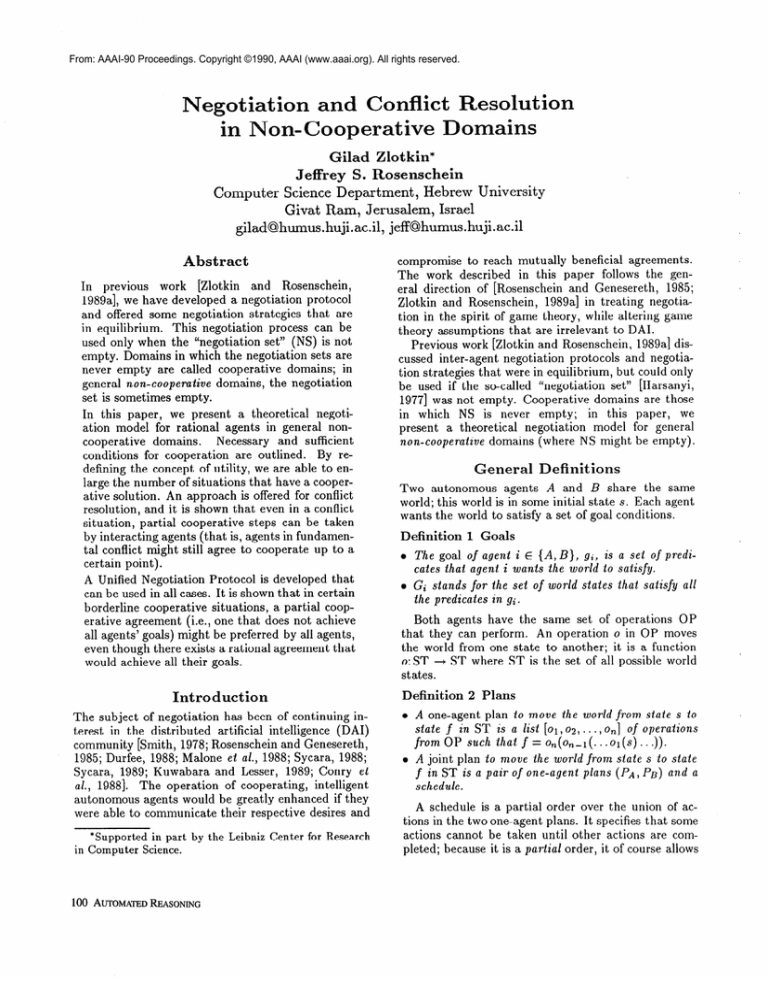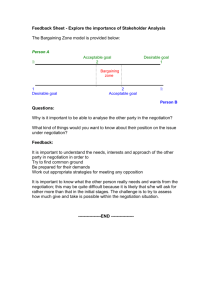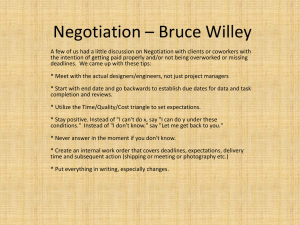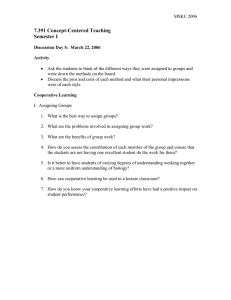
From: AAAI-90 Proceedings. Copyright ©1990, AAAI (www.aaai.org). All rights reserved.
Negotiation
and Conflict Resolution
in Non-Cooperative
Domains
Gilad Zlotkin*
Jeffrey S. Rosenschein
Computer Science Department, Hebrew University
Givat Ram, Jerusalem, Israel
gilad@humus.huji.ac.il, jeffQhumus.huji.ac.il
Abstract
work
[Zlotkin
and Rosenschein,
In previous
1989a], we have developed a negotiation protocol
and offered some negotiation
strategies that are
This negotiation
process can be
in equilibrium.
used only when the “negotiation set” (NS) is not
empty. Domains in which the negotiation sets are
never empty are called cooperative
domains; in
general non-cooperative
domains, the negotiation
set is sometimes empty.
negotiIn this paper, we present a theoretical
ation model for rational agents in general nonNecessary
and sufficient
cooper at ive domains.
conditions for cooperation
are outlined.
By redefining the concept of utility, we are able to enlarge the number of situations that have a cooperative solution. An approach is offered for conflict
resolution, and it is shown that even in a conflict
situation, partial cooperative
steps can be taken
by interacting agents (that is, agents in fundamental conflict might still agree to cooperate up to a
certain point).
A Unified Negotiation Protocol is developed that
can be used in all cases. It is shown that in certain
borderline cooperative
situations, a partial cooperative agreement (i.e., one that does not achieve
all agents’ goals) might be preferred by all agents,
even though there exists a rational agreement that
would achieve all their goals.
Introduction
The subject of negotiation has been of continuing interest in the distributed
artificial intelligence (DAI)
community [Smith, 1978; Rosenschein and Genesereth,
1985; Durfee, 1988; Malone et al., 1988; Sycara, 1988;
Sycara, 1989; Kuwabara and Lesser, 1989; Conry et
al., 19881. The operation of cooperating,
intelligent
autonomous agents would be greatly enhanced if they
were able to communicate
their respective desires and
*Supported in part by the Leibniz Center for Research
in Computer Science.
100 AUTOMATEDREASONING
compromise
to reach mutually beneficial agreements.
The work described
in this paper follows the general direction of [Rosenschein
and Genesereth,
1985;
Zlotkin and Rosenschein,
1989a] in treating negotiation in the spirit of game theory, while altering game
theory assumptions that are irrelevant to DAI.
Previous work [Zlotkin and Rosenschein, 1989a] discussed inter-agent negotiation protocols and negotiation strategies that were in equilibrium, but could only
be used if the s-called
“negotiation
set” [Harsanyi,
19771 was not empty. Cooperative
domains are those
in which NS is never empty;
in this paper,
we
present a theoretical
negotiation
model for general
non-cooperative
domains (where NS might be empty).
General
Definitions
Two autonomous
a.gents A and B share the same
world; this world is in some initial state s. Each agent
wants the world to satisfy a set of goal conditions.
Definition
1 Goals
o The goal of agent i E {A, B}, gi, is a set of predicates that agent i wants the world to satisfy.
0 Gd stands for
the predicates
the set of world states that satisfy all
in gi.
Both agents have the same set of operations
OP
An operation o in OP moves
that they can perform.
the world from one state to another; it is a function
o: ST + ST where ST is the set of all possible world
states.
Definition
2 Plans
A one-agent plan to move the world from. state s to
state f in ST is a list [ol, 02,. . . , on] of operations
from OP such that f = o,(o,-I(.
. .01(s) . . .)).
A joint plan to move the world from state s to state
f in ST is a pair of one-agent plans (PA, PB) and a
schedule.
A schedule is a partial order over the union of actions in the two one-agent plans. It specifies that some
actions cannot be taken until other actions are completed; because it is a partial order, it of course allows
simultaneous actions by different agents. If the initial
state of the world is s and each agent i executes plan
Pi according to the schedule, then the final state of the
world will be f. We will sometimes write J to stand for
a joint plan (pA, pB).
Definition
For
each
Cost(P)
Cost: OP --) IN.
one-agent
plan P
=
[ol, 02,. . ., o,],
is defined to be Cizl
Cost(ok).
Costi( J)
For each joint plan J = (PA, PB),
fined to be Cost(e).
is de-
Note that cost is a function over an operation-it
independent of the state in which the operation is
carried out. This definition, however, is not critical to
the subsequent discussion.
Our theory is insensitive
to the precise definition of any single operation’s cost.
What is important is the ability of an agent to measure
the cost of a one-agent plan, and the cost of one agent’s
part of a joint multi-agent plan.
Definition
4 Best Plans
e s + f is the minimal Cost one-agent
plan that
moves the world from state s to state f. If a plan
like this does not exist, then s ----ff is undefined.
0 s + F (where s is a world state und F is a set
of world states) is the minimal Cost one-agent plan
that moves the world from state s to one of the states
2n F:
Cost(s ---) F) =
Example:
There
min
Cost(s
is defined
f ~F:s+f
The Blocks
World
is a table and a set of blocks.
of a stack
are only
a bounded
PickUp( i) -
Pick
whenever
up the
top
time.
An
agent
into
can hold
Each operation
which
operations
block
is currently
no more
than
there
blocks
in this world:
in slot
slot i is not empty),
Put down the block which
slot i.
on the table
of slots
are two
i (can
be
and PutDown
being
held into
one block
at a
costs 1.l
Underlying
Each
agent Knows all rel-
4. Fixed Goals: Though the agents negotiate with one
another over operations, their goals remain fixed.
Negotiation:
In a multi-agent
en5. Bilateral
counter, negotiation is done between a pair of agents
at a time.
Deals
and the Negotiation
Assumptions
In [Zlotkin and Rosenschein,
1989a], we introduced
several assumptions that are in force for our discussion
here as well (the final two assumptions
were implicit
in previous work):2
Set
The agents negotiate on a joint plan that brings
world to a s tate that satisfies both agents’ goals.
Definition
the
5 Deals
o A Pure Deal is a joint plan (PA, PB) that moves the
world from state s to a state in GA n Gg.
e A Deal is a mixed joint plan (PA, PB): p; 0 5 p 5
1 EIR.
The semantics of a Deal is that the agents will perform the joint plan (PA, PB) with probability p, or the
symmetric joint plan (PB, PA) with probability 1 - p.
is a Deal, then Costi
is defined to be
l-p)Costj
(J) (where j is i’s opponent).
e If 6 is a Deal,
Domain
A block can be on the
However,
number
There
can be placed.
executed
of blocks.
Each agent wants to maximize
Knowledge:
2. Complete
evant information.
0 Ifs = (J:p)
pCosti( J)+(
---) f)
table or on some other block, and there is no limit to the
height
Utility Maximizer:
his expected utility.
There is no consideration
given by the
3. No History:
agents to the past or future; each negotiation stands
alone.
3 Costs
There exists a cost function,
1.
Cost(s
+
Gi)
-
then
Utilityi
is defined
to be
Cost&).
The utility for an agent from a deal is simply the
diflerence between the cost of achieving his goal alone
and his expected part of the deal.
A Deal
Utilityi
S
is individual
2 0.
rational
ii
for
all i,
A Deal 6 is pareto optimal if there does not exist unother Deal which dominates it-there
does not exist
another Deal which is better for one of the agents
and not worse for the other.
The negotiation set NS is the set of all the deals that
are both individual rational and pureto optimal.
These definitions of an individual rational deal, a
pareto optimal deal, and the negotiation set NS are
standard definitions from game theory and bargaining
theory (see, for example, [Lute and Raiffa, 1957; Nash,
1950; Harsanyi, 19771).
1989a]. Future work will further examine the consequences
of removing
one or more of these assumptions,
such as
the No History assumption
and the Bilateral
Negotiation
assumption.
ZLOTKINANDROSENSCHEIN
101
Conditions
for Cooperation
A necessary condition for NS to be non-empty is that
there is no contradiction
between the two agents’ goals,
i.e., GA n Gg # 0.3 Th is condition is not sufficient,
however, because even when there is no contradiction
between agents’ goals, there may still be a conflict between them. In such a conflict situation, any joint plan
that satisfies the union of goals will cost one agent (or
both) more than he would have spent achieving his own
goal in isolation (that is, no deal is individual rational).
Example:
The initial state can be seen at the left in
Figure 1. gA is “The Black block is at slot 2 but not on
the table” and gB is “The White
block is at slot 1 but
not on the table”.
In order
to achieve
execute one Pickup
Gi ) = 2.
because
them
The
there
both,
There
two
each
do not contradict
a state
exist
in the world
a joint
plan
that
8--that
has to
Cost(s
each
which
-+
other,
satisfies
side of Figure
moves
state to a state that satisfies
cost less than
agent
one PutDown;
as can be seen on the right
does not
total
goals
exists
from the initial
with
his goal alone,
and then
1.
the world
the twogoals
is, no deal is individual
rational.
Figure 1: Conflict
achievable
exists even though
union of goals is
l
6 Sum and Min
Conditions
A joint plan J will be said to satisfy the sum condition if
C
Cost(s
*
Gi) 2
iE(A,B}
C
%(A,B}
min
Cost(s
~E(A,B}
----)Gi) >
-
min
iE{A,B)
Costi(
Theorem 1 There exists a joint plan that moves the
world from its initial state s to a state in GA nGB and
also satisfies the sum and the min conditions,
if and
only if NS # 8.
the
states
of Theorem 1 are true, we will
are cooperative.
Redefinition
of Utility
In non-conflict
situations, if neither the min nor the
sum conditions are true, then in order for the agents
to cooperatively bring the world to a state in GA nGB,
at least one of them will have do more than if he were
alone in the world and achieved only his own goals.
Will either one of them agree to do extra work? It
depends on how important each gi is to agent i, i.e.,
how much i is willing to pa.y in order to bring the world
to a state in Gi.
The Worth
of a Goal
Definition 7 Let Wi be the maximum
that agent i is willing to pay in order
goal gi.
expected
cost
to achieve his
We assume that such an upper bound exists. There
may be situations and domains in which there is no
limit to the cost that an agent is willing to pay in
order to achieve his goal-he
would be willing to pay
any cost (see [Zlotkin and Rosenschein,
1989b]). That
situation, however, is beyond the scope of this paper.
The declaration of Utility can be usefully altered as
follows :
that
exist
in the
intersection
of the
agents’ goal sets might, of course, not be reachable given
the domain of actions that the agents have at their disposal.
See [Zlotkin and Rosenschein,
1989b]for an example of a
domain in which such a situation can occur.
102AUTOMATEDREASONING
is defined
The utility for an agent of a deal is the difference
between Wi and the cost of his part of the deal. If an
agent achieves his goal alone, his utility is the difference
between the worth of the goal and the cost that he pays
to achieve the goal.
Theorem 2 If in Definition 6 we change every occurrence of Cost(s -+ Gi) to Wi, then Theorem 1 is still
true.
Types
Costs.
a A joint plan J will be said to satisfy the min condition if
3All
When the conditions
say that the situations
Definition 8 IfS is a deal, then Utility,(b)
to be Wi - Cost@).
The existence of a joint plan that moves the world
from its initial state s to a state in GA n Gg is a necessary condition for NS to be non-empty.
When this
condition is not true, we will call it a conflict situation. Ways in which this conflict can be resolved will
be discussed in the Conflict Resolution section below.
Definition
Proof.
For the proof of this theorem and subsequent
q
theorems, see [Zlotkin and Rosenschein, 1990a].
of Interactions
Before the redefinition of utility, we had two possible
situations for agent interaction:
conflict and cooperative. A conflict situation implied a contradiction
between the agents’ goals, or a cost to achieving the union
of their goals that was so high, no deal was individual
rational.
Now that utility has been redefined, we have three
possible situations for agent interaction: conflict, compromise, and cooperative.
e A conflict
situation
is one in which (as before)
the negotiation set is empty-no
individual rational
deals exist.
o A compromise situation is one where there are individual rational deals. However, agents would prefer
to be alone in the world, and to accomplish
their
goals alone. Since they are forced to cope with the
presence of other agents, they will agree on a deal.
All of the deals in NS are better for both agents than
leaving the world in its initial state s.
o A cooperative situation is one in which there exists a
deal in the negotiation set that is preferred by both
agents over achieving their goals alone. Here, every
agent welcomes the existence of the other agents.
When the negotiation set is not empty, we can distinguish between compromise
and cooperative
situations using the following criterion.
If for all i, Wi 5
Cost(s ---) Gi) and NS # 0, then it is a cooperative
situation; otherwise, it is a compromise situation.4
Conflict
Resolution
What can be done when the agents are in a conflict
situation?
If we dropped Assumption
3 (“No History”),
then
we could offer some mechanism in which agents can
“buy their freedom” by making a promise to their opponent regarding future actions. In this case, they will
negotiate over the price of freedom.
A discussion of
altering utilities through promises, however, is beyond
the scope of this paper.
A simpler solution would be for the agents to flip
a coin in order to decide who is going to achieve his
goal and who is going to be disappointed.
In this case
they will negotiate on the probabilities (weightings) of
the coin toss. If they run into a conflict during the
negotiation (fail to agree on the coin toss weighting),
the world will stay in its initial state s.~
Utility for agent i in general is the difference between
the worth for i of the final state of the world and the
cost that i spends in order to bring the world to its
final state.
If agent i wins the coin toss, then he can reach his
goal. In this case, his utility is Wi (the worth of his
goal) minus the cost he has to spend in order to bring
the word to a state that satisfies his goal. If agent i
loses the coin toss, his opponent is going to bring the
world to a state that satisfies his opponent’s goal. This
state will not satisfy gd (otherwise it would not be a
conflict situation).
The final state of the world in this
case is worth 0 to agent i, but he is not going to spend
anything to bring the world to this state, so his total
utility in the case where he loses the coin toss is 0.
If the agents agree to flip a coin with weighting q,
then the utility for agent i of such a deal is qi(Wi 4An example of a compromise situation can be found in
Figure 1 when Wi is greater than 4.
5There is a sp ecial case where the initial state s already
satisfies one of the agent’s goals, let’s say agent A (S cannot
satisfy both goals since then we would not have a conflict
situation).
In this case, the only agreement
that can be
reached is to leave the world in state s. Agent A will not
agree to any other deal and will cause the negotiation
to
fail.
COst(s + Gi)), where qA = q; qB = 1 - q.
Example:
There is one block at slot 1. gA is “The
block
WA
is at slot 2” and
=
gB is “The
WB = 22.
12 , and
The
block
agents
is at slot 3”;
will agree
here
on the deal that
a coin with
utility
will give them the same utility-to
flip
3. This deal will give them each a
weighting
of &j.”
Cooperation
in Conflict
Resolution
The agen .ts may find that, instead of simply flipping
a coin in a conflict si tuation, it is better for them to
cooperatively
reach a new world state (not satisfying
either of their goals) and then to flip the coin in o;deF
to decide whose goal will ultimately be satisfied.
Example:
in slot
One agent wants the block currently
1 to be in slot 2; the other agent wants it to be in slot
3.
In addition,
both
the two blocks
order).
share
12.
The
they
them
a utility
hand,
they
of 2 each),
will agree
his goal
decide to flip a coin in the initial
3(12
-
of 4, which
10)).
the world
brings
If, on the
to do the swap cooperatively
bringing
WA =
that
of achieving
on a weighting
of 1 (i.e.,
decide
goal of swapping
reverse the stack’s
2. Assume
cost for an agent
alone is 10. If the agents
state,
the
in slot 4 (i.e.,
See the left side of Figure
=
WB
agents
currently
to the state
other
(at
shown
cost
on the
right of Figure 2, and then flip a coin, they will still agree
on a weighting
of 3, which
of 4 (i.e.,
-
+(12
2 -
brings them
an overall
utility
2)).
Iii
B
11R
1234
-m
Figure 2: Cooperation
B
l!!l
4
123
up to a certain point
Definition 9 A Semi-Cooperative
Deal is a tuple
(t, J,q) where t is a world state, J is a mixed joint
plan that moves the world from the initial state s to
state t, and 0 5 q 5 1 E R is the weighting of the coin
toss-the
probability that agent A will achieve his goal.
The semantics of such a deal is that the two agents
will perform the mixed joint plan J, and will bring the
world to state t; then, in state t, they will flip a coin
with weighting q in order to decide who continues the
plan towards their own goal.
Definition
UtilitYi(t,
10
J,c~)
=
qi(Wi
=
qi(W
-(l
6We have $(l2
- Costi
-
-
Cost(t
4
G;))
qi)Costi(J)
-
- 2) = +(22
Costi(t
+
Gi))
-
Costa(J)
- 2) = $L.
ZLOTKINANDROSENSCHEIN
103
Unified
Negotiation
Protocol
(UNP)
In cooperative
and compromise situations, the agents
negotiate on deals that are mixed joint plans, J:p (cooperative deals). In a conflict situation, the agents ne;$i$e
on deals of the form (t, J, q) (semi-cooperative
.
We would like to find a Unified Negotiation Protocol (UNP) that the agents can use in any situation.
The main benefit would be that the agents would not
have to know (or even to agree), prior to the negotiation process, on the type of situation that they are
in. Determining whether the situation is cooperative
or not may be difficult.
An agent may not have full
information at the beginning of a negotiation; he may
gain more information during the negotiation, for example, from the deals that his opponents are offering,
a.nd from computations
he himself is doing in order to
generate the next offered deal. Agents may only know
near the end of a negotiation just what kind of situation they are in.
The semi-cooperative
deals (t , J, Q) are general
enough so that, with some minor changes in the definition of utility, they may be used in the Unified Negotiation Protocol.
A cooperative deal which is a mixed
joint plan J:p can also be represented as (J(s), J:p, 0)
where J(s) is the final world state resulting from the
joint plan J when the initial state is s. J(s) is in
GA n GB, so the result of the coin flip at state J(s)
does not really matter (since none of the agents would
want to change the state of the world anyway).
What we advocate is for agents to negotiate always
using semi-cooperative
deals. A cooperative agreement
can still be reached (when the situation is cooperative)
because the cooperative deals are a subset of the semicooperative deals.
It is easy to see that whenever fA, fB $ GA fl Gg,
then the definition of utility in Definition 10 is the same
as that in Definition 11.
UNP
11
o If (t, J, q) is a semi-cooperative
deal, then fi will be
defined as the final state of the world when agent i
wins the coin toss in state t. fi = (t + Gi)(t) E Gi.
= Wi when fj E Gi, otherwise it is 0.
e W(fj)
o Utilityi(t, J,q)
= qi(Wi - Costi(t
-+ Gi)) + (1 qa)W(fj)
- Costi( J)
e Two deals dl, d2 (cooperative
or semi-cooperative)
will be said to be equivalent
if Vi Utilityi
=
The calculation of the utility of each
Utilityi(
deal is done according to the type of the deal (coop.
erative or semi-cooperative).
Theorem
3 If Vi Wa 2 Cost(s
-
Gi),
then NS # 0.
Situation
In a cooperative situation, there is always an individual rational cooperative deal, where both agents’ goals
are satisfied.
One might expect that in such a situation, even if the agents use the Unified Negotiation
Protocol,
they will agree on a semi-cooperative
deal
that is equivalent to the cooperative
deal, i.e., both
goals would be achieved. Surprisingly, this is not the
case: there might exist a semi-cooperative
deal that
dominates all cooperative
deals and does 7102 achieve
both agents’ goals. See the example below.
It turns out that this is a borderline
situation,
brought about because Wi is low. As long as Wi is high
enough, any semi-cooperative
deal that agents agree on
in a cooperative situation will be equivalent to a cooperat ive deal.
Example:
T h e initial situation
in Figure 3 consists of
5 duplications
of the example from Figure 1, in slots 1
to 15. In addition,
two slots (16 and 17) each contain
a stack of 2 blocks.
gA is “Black blocks are in slots
2,5,8,11
and 14 but not on the table; the blocks in slots
16 and 17 are swapped”
is “White
(i.e.,
each tower
are in slots 1,4,7,10
blocks
the table; the blocks
is reversed).
1
in slots 16 and
3
2
17 are swapped”.
Figure 3: Semi-Cooperative
tive Situation
goals.
The
i((8
x
cost joint
cooperative
deal
5) + (4 x
all i, Utility,(J:
where
the
the other
cost joint
because
2)).
This
in slots
17
in a Coopera-
plan that
achieves
J: 4 satisfies
for all i, Costi(J:
situation
16 and
slots are unchanged.
plan that moves the
the
min
and
For
Let t be the state
17 are swapped,
Let
world
both
3) = 24 =
is cooperative.
4) = 26 - 24 = 2.
blocks
16
= 26 = (2 x 5) + (8 x 2).
minimal
the sum conditions,
15
Agreement
--f Gi)
For all i, Cost(s
Let J be the
14
13
$Q
and 13 but not on
Jludl...rnHRH~
I
Definition
in a Cooperative
and
T be the minimal
to state t.
For all
i, Utilityi(t, T: $,+ ) = +(26 - (2 x 5)) - (2 x 2) =
4. The semi-cooperative
deal (t,T:$,
3) thus dominates
deal J:$
Gd) then agent i cannot even
If wi < Cost(s achieve his goal alone. This does not necessarily mean
that NS is empty-Theorem
3 stated in the opposite
direction is not true.
the cooperative
situation.
Theorem 4 For a semi-cooperative
deal (t, J, q) E
NS, if there exists an i such that fi E GA n Gg, then
this semi-cooperative
deal is equivalent to some cooperative deal.
We have presented
a theoretical
negotiation
model
that encompasses
both cooperative
and conflict situations. Necessary and sufficient conditions for cooperation were outlined.
By redefining the concept of
104 AUTOMATEDREASONING
even though
;t is a cooperative
Conclusions
utility, a new boundary
type of interaction,
a comA solution was
promise situation, was demarcated.
offered for conflict resolution, and it was shown that
even in a conflict situation, partial cooperative
steps
can
be taken by interacting agents. A Unified Negotiation Protocol was developed that can be used in all
ca.ses, whether cooperative, compromise, or conflict. It
was shown that in certain borderline cooperative situa.tions, a partial cooperative agreement (i.e., one that
does not achieve all agents’ goals) might be preferred
by all agents.
References
[Sycara, 19891 Katia P. Sycara. Argumentation:
Planning other agents’ plans. In Proceedings of the The
Eleventh International
Joint Conference
on Art&
pages 517-523, Detroit, Michigan,
cial Intelligence,
August 1989.
[Zlotkin and Rosenschein,
1989a] Gilad Zlotkin
and
Jeffrey S. Rosenschein.
Negotiation and task sharing among autonomous
agents in cooperative
doIn Proceedings
of the The Eleventh Intermains.
national Joint Conference
on Artificial Intelligence,
pages 912-917, Detroit, Michigan, August 1989. The
International Joint Conference on Artificial Intelligence.
[Conry et al., 19883 S usan E. Conry, Robert A. Meyer,
and Victor R. Lesser. Multistage negotiation in distributed planning. In Alan H. Bond and Les Gasser,
in Distributed
Artificial Intellieditors, Readings
gence, pages 367-384. Morgan Kaufmann Publishers, Inc., San Mateo, California, 1988.
[Zlotkin and Rosenschein, 198981 Gilad Zlotkin
and
Jeffrey S. Rosenschein.
Negotiation and t’ask sharing in a non-cooperative
domain.
In Proceedings
of the Ninth
Workshop
on Distributed
Artificial
Intelligence,
pages 307-327,
Rosario, Washington,
September 1989.
[Durfee, 19883 Edmund H. Durfee.
Coordination
of
Distributed Problem Solvers. Kluwer Academic Publishers, Boston, 1988.
[Zlotkin and Rosenschein, 1990a] Gilad Zlotkin
and
Jeffrey S. Rosenschein.
Negotiation and conflict resolution in non-cooperative
domains. Technical Report 90-6, Computer Science Department,
Hebrew
University, Jerusalem, Israel, 1990.
[Harsanyi, 197’71 John C. Harsanyi.
Rational Behavior and Bargaining
Equilibrium
in Games and Social Situations.
Cambridge University Press, Cambridge, 1977.
[Kuwabara and Lesser, 19891 Kazuhiro Kuwabara and
Victor R. Lesser. Extended protocol for multistage
negotiation.
In Proceedings of the Ninth Workshop
on Distributed Artificial Intelligence, pages 129-161,
Rosario, Washington, September 1989.
[Zlotkin and Rosenschein, 1990b] Gilad Zlotkin
and
Jeffrey S. Rosenschein.
Negotiation and goal relaxation. Technical report, Computer Science Department, Hebrew University, Jerusalem, Isra.el, 1990.
In preparation.
[Lute and Raiffa, 19571 R. Duncan Lute and Howard
Raiffa. Games and Decisions.
John Wiley & Sons,
Inc., New York, 1957.
[Malone et al., 19883 Thomas W. Malone, Richard E.
Fikes, and M. T. Howard.
Enterprise:
A marketlike task scheduler for distributed
computing environments.
In B. A. Huberman,
editor, The Ecolpages 177-205. North-Holland
ogy of Computation,
Publishing Company, Amsterdam,
1988.
[Nash, 19501 John F. Nash.
Econometrica,
28:155-162,
The bargaining
1950.
problem.
[Rosenschein and Genesereth, 19853 Jeffrey S. Rosenschein and Michael R. Genesereth.
Deals among
of the Ninth Interrational agents. In Proceedings
national Joint Conference
on Artificial Intelligence,
pages 91-99, Los Angeles, California, August 1985.
[Smith, 19781 Reid G. Smith. A Framework for Problem Solving in a Distributed
Processing
Environment. PhD thesis, Stanford University, 1978.
[Sycara, 19881 Katia P. Sycara.
Resolving goal conflicts via negotiation.
In Proceedings
of the Seventh
National Conference
on Artificial Intelligence, pages
245-250, St. Paul, Minnesota, August 1988.
ZLOTKIN
AND
ROSENSCHEIN
105





